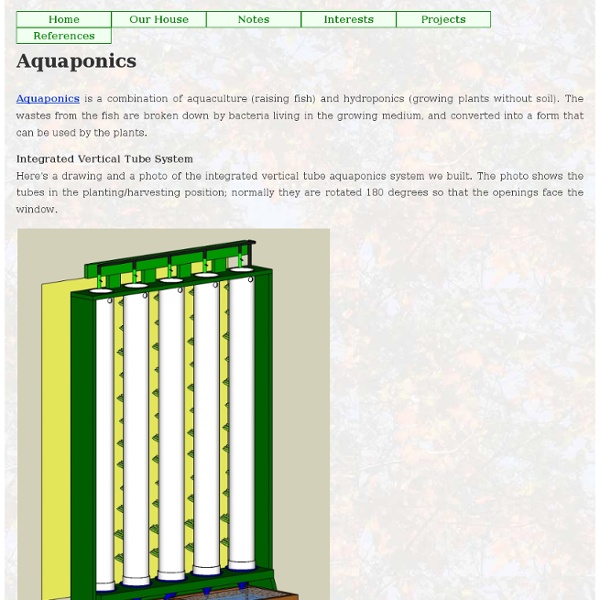Aquaponics
Aquaponics is a combination of aquaculture (raising fish) and hydroponics (growing plants without soil). The wastes from the fish are broken down by bacteria living in the growing medium, and converted into a form that can be used by the plants. Integrated Vertical Tube System Here's a drawing and a photo of the integrated vertical tube aquaponics system we built. The photo shows the tubes in the planting/harvesting position; normally they are rotated 180 degrees so that the openings face the window. I made the drawing using Google SketchUp, a great free 3-D drawing program. To make the grow tubes, I cut slots across with a hack saw and then heated the plastic with a heat gun to soften it. The PVC caps on the bottom of the tubes have slots cut around the edges with a table saw, so that any water that might drip out around the plants can just run down the outside of the tube and through the slots. April 3, 2007 We got fish today! 8-14-2007 We've got babies!
UV Lamps And Lamp Types
UVC Production by Germicidal UV Lamps There are many types of lamps that artificially produce UV. There are UV lamps for tanning, for counterfeit money detection, blacklight stage lamps and lamps for mineral displays, lamps that produce Ozone and germicidal UV lamps. UV Lamps – History and Development UV light is artificially produced by mercury vapor low and medium pressure lamps. All germicidal UV lamps have secondary emissions, including small amounts of UVA, UVB, visible light (above 400nm wavelength) and heat. As with all gas discharge lamps, the UV output of germicidal lamps is reduced when the temperature of the lamp surface deviates from the optimum. For effective UV disinfection not only the temperature but the transparency or transmittance of the medium for UVC at 253.7nm wavelength is of great importance. The reducing factors must be taken under consideration when sizing the UV lamps for an effective UV disinfecting process. UV Lamp Types Cold Cathode Germicidal UV Lamps
Super Bright LEDs - LED Information
LEDS are static sensitive devices. Observe static sensitivity handling precautions, such as wearing a grounded wrist strap when handling. When forming leads, the leads should be bent at a point at least 3 mm from the base of the led Avoid damage to LEDS by soldering for no longer than 3 seconds with 700° iron The following information applies only to single LED components, not LED Bulbs and Products. All of our LED bulbs and products have resistors built-in for operation at their rated voltages. The unit of measure commonly used to describe LED intensity is the millicandela (mcd), 1000 millicandela equals 1 candela. The unit of measure commonly used for most other light sources is the Lumen. To use leds for 12 Volt applications you must simply connect a resistor in series with the led or leds. Purchase LED Resistors See our LED car bulb pages for LED bulbs designed to work on 12 Volt systems The Current State of Solid State Lighting - SSL Circuitboards.com Don's LED Pages LED Center
Solid State Lighting Design - LED Lighting for General Illumination and Architecture
SatisLED Store
Related:
Related:



